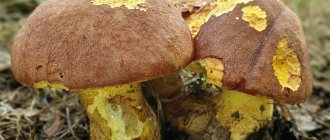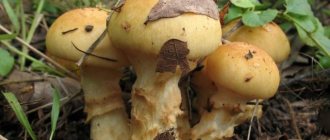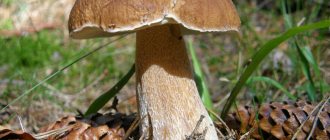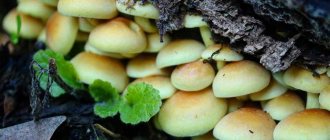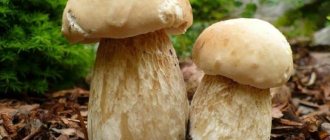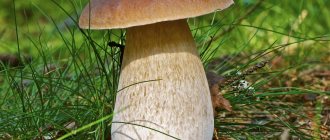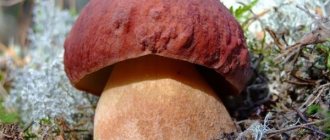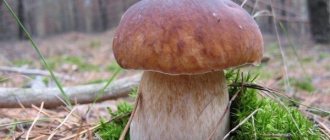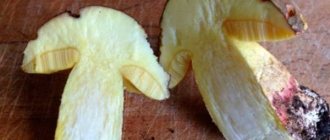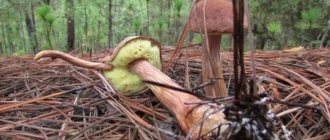The semi-white mushroom or, as it is also called, the yellow boletus (Boletus impolitus) belongs to the Boletaceae family. In some areas of our homeland it is called lemongrass (lemon). Genus: boletus. We have known about this mushroom since childhood, since there are a lot of references to boletus mushrooms in Russian literature. However, this mushroom has a more common name in science and is called semi-white.
There are many boletus species, but it is the semi-white species that deserves special consideration. It has nutritional qualities and properties that no other mushroom in the family can boast of. Let's find out what exactly we are talking about.
Description and photo of the Half-white mushroom
How do you understand that you have found a boletus in the forest? What characteristic differences will set it apart from other mushrooms?
Experienced mushroom pickers will probably tell you that you need to pay attention to the appearance of the boletus mushroom. This is true. And according to some characteristics, you can actually understand that this is exactly the representative of the family.
Hemileccinum impolitum - from Latin.
hat
Let's start the description with the cap. It has an impressive diameter of up to 20 cm. Average individuals have a diameter of about 15 cm. The diameter of the cap is approximately 5 cm, in thickness, but at a more mature age it grows to 20 centimeters.
The hat is very fleshy, yet elastic. However, with age it becomes more pliable.
Over time, the boletus becomes completely flat as it matures.
If you run your hand over the cap, you will realize that it is somewhat wrinkled and smooth. At the same time, the color of the cap itself has a yellow-brown tint.
As soon as dry weather sets in and the cap dries out, cracks will form on it. However, during wet weather the cap becomes covered with mucus again.
The cap gives off a pleasant aroma, which is very similar to the smell of champignons.
Leg
As for the stem, it is mostly solid, tuberous and at the same time thick. Its height also varies. At an early age, the boletus stalk is about 4 or 5 cm in height. With age, the mushroom rises to a height of up to 12 cm. It is clearly visible among grass and plants.
As for the girth of the leg, it can reach from 2 to 6 cm in diameter, that is, it is very stable. The leg has a yellowish color, but becomes browner with age. On the very surface of the leg there are peculiar nets, which imply small brown scales.
Pulp
As for the flesh of the militant, it is very dense, without a characteristic smell. At the same time, the color of the flesh is bright yellow, and the older the mushroom, the more its color stands out. However, if you cut into a mushroom and leave its softness to interact with oxygen, it will very soon take on a bluish tint.
As for the spores, they are stored in special tubes, the length of which is about 2 cm. These tubes are very smooth and have a slightly bluish tint.
The spores themselves are also smooth and fusiform. The spore powder itself does not have an olive color, however, it acquires it with age.
Distinctive features
The tubular mushroom has many distinctive features:
- strong, fleshy structure of the fruit stem and cap element, their structure suggests large sizes;
- attractive to parasites and pests;
- the spongy surface of the spore-bearing part can change color with age or when pressed;
- ability to accumulate large amounts of water;
- strong mushroom aroma and bright taste of the pulp;
- the number of edible species predominates.
Lamellar mushrooms differ from tubular mushrooms in their hymenophore, which is presented in the form of separate radial plates. The difference between them is also evident in the description of the pulp: spongy ones are denser, while plastic ones are susceptible to crumbling. Differences are also observed in the shape of the cap, where a convex hemisphere is more common for tubular ones, and a horizontal, flat upper part for lamellar ones. Similarities are observed in the color scheme of the edible fruiting bodies.
Irina Selyutina (Biologist):
The tubular-type hymenophore is characteristic of boletes and tinder fungi. It is represented by a mass of tubes opening downward, etc. sending ripened fungal spores into life. Almost always the tubes grow together, resulting in the formation of a solid mass, but in the liverwort the tubes are easy to separate from each other; they are free, because do not fuse with the side walls. Important systematic features are the size and shape of the pores. They can be regular, round or angular in shape. The color of the pores may differ from the color of the layer of tubules, which will be especially noticeable in the section of the hymenophore.
A less popular group of marsupials that grow above and below ground. The spores ripen inside the mushroom body, which looks like a ball or oval. Therefore, tubular saprotrophs, as well as lamellar saprotrophs, belonging to the same basidial group, are strikingly different from marsupials.
Edibility of the semi-white mushroom
Yellow boletus belongs to the category of edible mushrooms. It is used in the preparation of various dishes, and it is absolutely safe for people. Therefore, it undergoes minimal heat treatment before cooking. As for the taste qualities of this forest dweller, they belong to the second category. The mushroom is suitable for consumption mainly fresh; less often it can be found in dried or canned form.
It is not only included in various dishes, but is also an excellent seasoning.
Calorie content and beneficial properties
Despite the fact that the mushroom is rightfully edible and absolutely harmless to humans, it should not be eaten by those losing weight. There are about 300 kilocalories per 100g of mushroom. Yes, and this mushroom is very high in calories, if you consume it especially in the afternoon, you will gain extra pounds, especially if you abuse it.
However, if you decide to eat boletus once, and do not plan to repeat it in the near future, then a one-time snack like this is allowed.
However, despite its calorie content, this mushroom is extremely useful. For example, it contains a huge amount of minerals, nutrients, vitamins and antioxidants.
Where do yellow boletus grow?
Boletus is an incredibly tasty mushroom, and also very healthy. Based on it, you can make various decoctions and other traditional medicine recipes that will certainly be useful to you in treatment.
However, this mushroom is still highly valued for its pleasant taste and aroma. Pickled boletus has received special love, which will delight you at any time of the year.
So, in order to find boletus, you need to know when to search. We recommend that you go on a quiet hunt between July and October.
This mushroom loves shady forests and moist soils. Therefore, the ideal place for its existence is mixed or deciduous forests, where beech and oak predominate.
Most often, this mushroom is found in Western Europe, however, it is also incredibly easy to find in the western part of Russia.
In our country, the yellow boletus is most widespread in Europe, as well as in the Ussuri region and in the Sochi Nature Reserve.
The mushroom harvest itself occurs in autumn, if it was warm. Then the collection takes place in October, and sometimes even in November. However, if the autumn turned out to be cold, then it is recommended to collect this mushroom no earlier than in early November.
The semi-white mushroom is on Wikipedia.
Similar species
What forest inhabitants can you easily confuse the boletus with? There may be many options, however, the answer is obvious. The boletus family includes a huge number of mushrooms and species that thrive in forests, moreover, they grow in abundance in Russia.
Let's get acquainted with the most common types that you may likely encounter on your way.
Maiden's boletus
This mushroom has a very interesting and intricate name. It is edible and also belongs to the boletaceae family.
Is a boletus.
Its appearance vaguely resembles a semi-white mushroom. Its cap has a maximum diameter of 20 cm. The shape is predominantly convex, and the edges are curved inward. It seems quite thin, the cap has a golden hue, much less often red or brown.
The pulp itself is very dense and also has a blue tint when cut.
The leg reaches a maximum height of 15 cm, very thick, up to 6 cm in diameter.
This species is widespread in southern Europe, however, such boletus cannot be found in large groups. Likes to grow alone. Basically, it bears fruit during the early autumn stage.
Boletus root
Another representative of the Boletaceae family, the boletus genus. A mushroom that will certainly not go unnoticed.
Very large, the cap can reach a diameter of up to 30 cm. At the very beginning of growth, it has a cone-shaped shape, but then it takes on a flatter shape, the edges bend inward.
The surface of such a cap is slightly woolly and can often crack.
The flesh of this mushroom has a lemon yellow tint, somewhat bluish. It does not have the most pleasant smell, and the taste is quite bitter.
The stem is thick, lifts the mushroom to a height of 12 cm. It has a yellow tint.
This mushroom is widespread throughout Europe and chooses only deciduous forests for its development. Loves calcareous and other neutral soils. And also prefers dryness. Grows from July to October.
Moss fly green
A mushroom widespread in Russia.
Very beautiful, attracts attention. Despite the name, it belongs to the boletus genus.
This mushroom is easy to spot in the forest. Its cap is small, reaching a diameter of 10 cm. Individuals measuring 16 cm are very rare. It is somewhat convex and very velvety. The flesh is white, however, when cut it turns blue.
The leg itself has a cylindrical shape, which tapers slightly towards the mycelium itself. It is about 10 cm in height and up to 2 centimeters in thickness.
Spore powder is brown, frequent.
This mushroom chooses a variety of forests for its growth. In addition, it also prefers clearings and roads.
The mushroom grows singly, and sometimes in groups. Can form mycorrhizae with deciduous and coniferous trees. He is cosmopolitan. It is equally often found in North America, Europe and Australia.
Boletus inedible
Inedible boletus can also be found in Russian forests. However, despite the fact that the name contains the word inedible, this mushroom is not poisonous. The fact is that it is unpleasant to prepare mainly because of its taste. However, it does not pose any danger to the human body.
In order not to confuse this inedible species with a simple porcini mushroom, you need to carefully study the description.
The hat can reach a diameter of up to 15 cm. It has a cone-shaped shape. Sometimes, slightly convex, the edges turn inward or hang in waves.
This hat is very smooth to the touch, somewhat matte and wrinkled. The skin has a light brown tint, but at a young age it is already brown or gray-brown in color.
The pulp itself has a cream or white tint, however, it can sometimes acquire a blue tint when cut. Quite bitter.
The leg rises 15 cm in height and is about 4 cm thick.
As for the tubular layer of this forest dweller, it has a lemon yellow tint; also, a greenish tint predominates. The spore powder itself is brown and olive in color.
This mushroom is widespread in the south of the European part of Russia; it most often chooses the Kaliningrad region for its place of residence. It is also common in Europe, namely in warm countries, such as Italy or Spain. It mainly chooses coniferous forests, also oak and broad-leaved forests. It prefers sandy and acidic soils, and also settles in places in parks and lawns.
Mushrooms grow between July and October.
Article on the topic - Porcini mushroom (Boletus): the king of mushrooms, doubles with photos.
Varieties with brown cap
Yellowness in color can be present not only in the cap color. The mushroom stem, pulp or spore layer may also be this color.
Polish mushroom with yellow sponge
Mushrooms are characterized by a convex hemispherical shape of caps from light brown to chocolate shades. The dry, velvety skin of the caps becomes covered with an oily coating in damp weather. The yellowish tubular layer turns blue when pressed. The stalk can be cylindrical or tuberous.
In the first case, it is often pointed at the base. The stem of the Polish mushroom is always lighter than the cap. Longitudinal dark brown strokes are clearly marked on its surface. The pulp of the fruit is light. It has a pleasant sweetish taste and a fruity or mushroom aroma.
Reshetnik with yellow pulp
Reshetnik is a tubular mushroom from the genus Buttercup. The mushroom is popularly called goat mushroom. Outwardly, it looks more like a moss fly. Only the cap of the butterfly is more convex and covered with a mucous layer, which is a characteristic feature of the butterfly. The goat's leg is painted the same color as its cap.
The mushroom's tubes are brownish-orange, and the yellow flesh turns red when exposed to air. The butterfly differs from other butterflies not only in the shape of the fruiting body. The surface of its cap is only slightly slimy, while that of most other members of the genus is highly oily.
Pepper oiler with yellow stem inside
The cap of the pepper butterfly varies from convex to flat-spread. Its surface is dry, slightly velvety to the touch. The leg is cylindrical, often curved. In most representatives of the species it is narrowed at the base.
The color of the leg matches the color of the cap and can be expressed in dark or light shades of brown. The hymenophore is expressed by tubes with large pores. The flesh of the mushroom is sulfur-yellow. It has a spicy peppery flavor, so this variety of butter dish is typically used to make mushroom seasonings.
Application in medicine
The semi-white mushroom is used not only in the preparation of various dishes, but is also widely used in medicine. Yes, you heard right. This mushroom is a main component in the development of various medicines.
So, find out which medicines this mushroom can be found in?
First, let's talk about the beneficial properties of boletus.
Let's start with the fact that it really has a pleasant taste and smell. However, when it comes to its chemical composition, we need to talk about its main components.
This mushroom contains a huge amount of antioxidants and other beneficial substances. All of them certainly have a positive effect on human health.
Scientists believe that if you regularly consume the semi-white mushroom in small quantities, you can significantly prevent the development of tumors. Also, prevent the occurrence of a heart attack or stroke. It is especially useful as a product that is used in food during post-operative recovery.
A special extract is obtained from the white mushroom itself, which is ideal for the treatment of various serious skin diseases.
Cosmetologists will also probably tell you that if you regularly wipe your face with boletus extract, your facial skin will immediately become very velvety and at the same time clean.
Also, the mushroom is used to treat wounds on the human body. True, for this you will already need a dried mushroom. A special powder is made from it, after which it is applied to already damaged areas of the skin. You need to do this procedure up to several times a day until you see that the healing process is going as it should.
Also, other qualities of the semi-white mushroom are known. For example, it can significantly strengthen the immune system and also has a positive effect on the treatment of sexual disorders.
People's truth
Let's look at the most popular recipes that are used in folk medicine and contain boletus mushroom.
The mushrooms are thoroughly dried. Then, they are thoroughly ground into powder in a regular coffee grinder. Afterwards, the mushroom can be used as an excellent spice.
About 40 ml of vodka is added to the resulting powder, and then about 2 tablespoons of sugar.
The mixture is thoroughly mixed. In order for it to have the desired effect, it should only be stored in the refrigerator. It is recommended to use it in food approximately 2 times a day, this should be done 30 minutes before meals.
Also, this tincture is recommended for use if you are actively fighting varicose veins. It also helps well with thrombophlebitis.
To do this, you are advised to rinse thoroughly with water and dry thoroughly. The mushrooms are carefully placed in a small jar, trying to fill it to the top.
The contents of the jar are carefully filled with alcohol, then closed with a nylon lid.
The entire mixture should infuse for about two days.
The resulting mixture is used to rub into the affected areas. This should be done about twice a day. The treatment period is up to several months.
Beneficial features
This red-yellow mushroom has a number of beneficial properties. It contains many amino acids and vitamins that are so necessary for the body.
The nutritional value:
- water – 83.5;
- fatty acids – 0.53;
- unsaturated fatty acids – 0.42;
- dietary fiber – 4.22;
- ash – 0.83;
- mono- and disaccharides – 1.15.
The beneficial substances in its composition strengthen the immune system and have a positive effect on the skin and hair. Vitamins A, D and group B relieve fatigue; this mushroom is especially useful for people who often experience stress.
Mushroom helps cope with stress
Cooking for 5+
Boletus is a very tasty mushroom. With it you can prepare a huge number of different dishes that will become a real decoration for your table. Let's find out which of the most proven recipes we are talking about.
Marinated boletus
This is a great appetizer and a great addition to any dish. In order to marinate boletus, it must be properly prepared.
To begin with, it is washed very well in water. At the same time, foreign elements in the form of soil, plant particles, needles, and so on are removed.
Then the mushrooms are well dried.
If the mushrooms are large enough, it is recommended to leave them in cold water for several hours. If the mushrooms themselves are small and not yet completely ripe, then there is no need to soak them.
Then, the mushrooms are removed from the water and boiled in salted water for 10 minutes.
Catch the mushrooms and place them on a towel. Let them cool, then cut them into several pieces.
- For the recipe you will need 1 kg of mushrooms.
- 500 ml water.
- 100 ml vinegar.
- Several onions.
- 1 tablespoon sugar.
- Salt a few tablespoons.
- Bay leaf, cloves, pepper.
Important! It is advisable to boil the mushrooms together with a bay leaf, then they will be more aromatic.
Then put a pot of water on the fire.
Add all the ingredients except mushrooms. Wait for the water to boil. Cook for about 15 minutes; if foam forms, remove it.
Place onions, mushrooms, and a few peppercorns in the jar. Everything is carefully poured into the marinade and rolled up with lids. The product can only be stored in the refrigerator.
